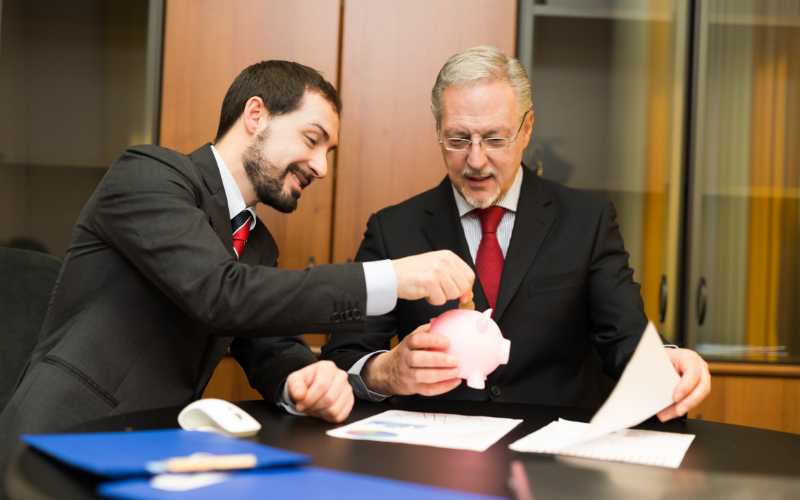

Mutual Funds
Regardless of whether you’re setting up new operations, or working on a small-scale business, or working to get your accounting straightened out, WAG Consulting has all the online Accounting support that you need
What Is the Concept of a Mutual Fund?
A mutual fund is a form of financial vehicle that pools money from multiple investors to invest in various securities, including stocks, bonds, money market instruments, and other properties. Mutual funds are managed by experienced portfolio managers who distribute the fund’s assets and seek to generate capital gains or income for investors. The portfolio of a mutual fund is organized and managed following the investment objectives specified in the prospectus.
Mutual funds provide access to professionally managed portfolios of stocks, shares, and other instruments for small and individual investors. As a result, each shareholder shares proportionately in the fund’s gains or losses. Mutual funds invest in a diverse range of assets, and success is typically measured in terms of the improvement in the fund’s overall market capitalization, which is calculated by aggregating the performance of the fund’s underlying investments.

IMPORTANT TAKEAWAYS
A mutual fund is a form of investment vehicle that invests in stocks, bonds, and other securities.
Mutual funds provide small and individual investors with low-cost access to diversified, professionally operated portfolios.
Mutual funds are classified into various categories based on the securities in which they invest, their investment goals, and the form of returns sought.
Annual fees (referred to as expense ratios) and, in some cases, commissions are charged by mutual funds, which may reduce their total returns.
The vast majority of money in employer-sponsored pension plans is invested in mutual funds.
Mutual Funds: An Introduction
Mutual funds pool capital from investors and invest it in other assets, usually stocks and bonds. The mutual fund company’s value is contingent upon the success of the securities it chooses to purchase. Thus, when you buy a mutual fund unit or share, you are purchasing the portfolio’s output or, more specifically, a portion of the portfolio’s value. Investing in a mutual fund is distinct from investing in individual stocks. Unlike stock, mutual fund shares do not confer voting rights on their investors. A mutual fund’s share reflects investments in a diverse range of stores (or other securities) rather than a single holding.
This is why the price of a mutual fund investment is often referred to as the net asset value (NAV) per share or NAVPS. The NAV of a fund is calculated by dividing the total value of the portfolio’s securities by the total number of shares outstanding. The total number of outstanding shares includes all shareholders, institutional investors, and business officers or insiders. Usually, mutual fund shares can be bought or redeemed at the fund’s current net asset value (NAV), which, unlike a stock price, does not fluctuate during market hours but is settled at the close of each trading day. As a result, when the NAVPS is paid, the price of a mutual fund is also changed.
The typical mutual fund invests in over a hundred different shares, which provides significant diversification at a low cost to shareholders. Consider an investor who purchases only Google stock before the company experiencing a challenging quarter. He risks losing a considerable amount of value because all of his dollars are tied to a single business. On the other hand, another investor can purchase shares of a mutual fund that includes Google stock. When Google has a bad quarter, she suffers considerably less loss than if Google were a more significant portion of the fund’s portfolio.
Mutual Funds and Their Operation
A mutual fund is both an investment vehicle and an entity in its own right. This dual nature can seem unusual, but it is analogous to how a share of AAPL represents Apple Inc. When an investor purchases Apple stock, they are acquiring a portion of the company and its assets. Similarly, an investor in a mutual fund is buying a part of the mutual fund business and its properties. The distinction between Apple and a mutual fund company is that Apple is in the business of creating creative devices and tablets, while a mutual fund company is in the business of investing.
Usually, investors receive a return from a mutual fund in one of three ways:
Dividends on securities and interest on bonds retained in the fund’s portfolio generate income. A fund distributes almost all of the money it earns throughout the year to fund members. Frequently, funds give investors the option of receiving a check for dividends or reinvesting the profits and acquiring additional shares.
If the fund sells shares at a profit, the fund earns a capital gain. Most funds also distribute these gains to clients.
Suppose the value of the fund’s holdings increases, but the fund manager does not sell them, the value of the fund’s shares increases. You can then sell the mutual fund shares in the market for a fee.
If a mutual fund is viewed as a virtual firm, the CEO is referred to as the fund manager, who is sometimes referred to as the investment advisor. The fund manager is hired by the board of directors and is legally required to act in the mutual fund shareholders’ best interests. The majority of fund managers have also funded owners. A mutual fund firm has a minimal number of other staff. The investment advisor or fund manager can hire analysts to make investment decisions or conduct market research. A fund accountant is retained to measure the fund’s net asset value, or NAV, which is the standard value of the portfolio that decides whether share prices rise or fall. Mutual funds must employ at least one enforcement officer and, most likely, an attorney to comply with federal regulations.
The majority of mutual funds are subsidiaries of a much larger investment company; the largest of these companies manage hundreds of independent mutual funds. Several fund companies are household names, including Fidelity Investments, The Vanguard Group, T. Rowe Price, and Oppenheimer & Co.
Mutual Fund Forms
Mutual funds are classified according to the types of assets they invest in and the type of returns they expect. There is a fund to fit virtually every investor or investment strategy. Other common mutual fund categories include:
- Money market funds.
- Sector funds.
- Alternative funds.
- Smart-beta funds.
- Target-date funds.
- Funds of funds.
- Mutual funds that invest in other mutual funds.
Funds of Equity
The most numerous group in equity or mutual funds. As implied by the term, this type of fund invests primarily in stocks. There are several subcategories within this category. Certain equity funds are labeled according to the company size they support: small-, mid- or large-cap. Others are classified according to their investment philosophy: rapid growth, income-oriented investing, value investing, etc.
Additionally, equity funds are classified according to whether they invest in domestic (U.S.) or international equities. There are many types of equity funds, owing to the diversity of equities. Utilizing a style box, an example of which is shown below is an excellent way to comprehend the universe of equity funds.
The idea is to categorize funds according to the size of the companies in which they invest (their market capitalizations) and the growth potential of the stocks in which they invest. The word “value fund” refers to an investment strategy that seeks out high-quality, slow-growth companies undervalued by the market. These businesses have a low price-to-earnings (P/E) ratio, a low price-to-book (P/B) ratio, and a high dividend yield. In comparison, spectrums are growth funds that invest in businesses that have experienced (or are expected to experience) rapid growth in profits, revenues, and cash flows. These firms usually have a high price-to-earnings ratio and do not pay dividends. A “blend” is a term that refers to companies that are neither value nor growth stocks but are listed as being in the middle.
The other dimension of the style box is the scale of the businesses in which a mutual fund invests. Market capitalizations of large-cap corporations exceed $10 billion. A company’s market capitalization is calculated by multiplying the share price by the number of outstanding shares. Large-cap stocks are usually well-known blue-chip companies. Small-cap stocks are those with a market capitalization of between $300 million and $2 billion. These smaller businesses are typically more risky investments due to their infancy. Mid-cap stocks bridge the divide between small and large-cap stocks.
A mutual fund’s strategy can incorporate elements of both investment style and company size. For instance, a large-cap value fund will seek out large-cap companies that are financially sound but have recently seen their share prices fall and would be located in the style box’s upper left quadrant (large and value). The inverse of this would be a fund that invests in high-growth technology startups: small-cap growth. A mutual fund of this kind will be located in the bottom right quadrant (small and change).
Fixed-Income Investment Trusts
Another sizable category is fixed income. A fixed-income mutual fund invests in fixed-income securities such as government bonds, corporate bonds, or other debt instruments that pay a fixed rate of return. The fund portfolio is supposed to produce interest income, which it then distributes to shareholders.
These funds, which are also referred to as bond funds, are often actively managed and aim to acquire relatively undervalued bonds to resell them at a profit. Although these mutual funds are expected to earn a higher rate of return than certificates of deposit or money market investments, bond funds are not risk-free. Due to the variety of bond forms, bond funds can vary significantly in their investment strategy. For instance, a fund that invests exclusively in high-yield junk bonds is considerably riskier than a fund that invests solely in government securities. Additionally, almost all bond funds are subject to interest rate risk, which means that the fund’s value decreases as rates rise.

Funds of Indexes
Another category, which has grown in popularity over the last few years, is referred to as “index funds.” Their investing philosophy is founded on the premise that it is challenging and often prohibitively costly to outperform the market consistently. Thus, the manager of an index fund purchases stocks that track a primary market index, such as the S&P 500 or the Dow Jones Industrial Average (DJIA). This policy necessitates less research from analysts and consultants, which results in fewer costs that eat into profits until they are passed on to shareholders. Frequently, these funds are structured with cost-conscious investors in mind.
Balanced funds
Balanced funds invest in a diversified portfolio of assets, including stocks, shares, money market instruments, and alternative investments. The goal is to minimize exposure risk across asset classes. Additionally, this type of fund is referred to as an asset allocation fund. There are two types of such funds, each of which is tailored to the investor’s goals.
Certain funds are characterized by a fixed allocation strategy, which provides investors with stable exposure to different asset classes. Other funds use a diverse distribution approach to accommodate a range of investor priorities. This could involve reacting to market dynamics, business cycle shifts, or the investor’s life phases.
Although dynamic allocation funds have similar goals to balanced funds, they must not hold a prescribed percentage of any asset class. As a result, the portfolio manager is free to adjust the asset allocation as necessary to sustain the fund’s specified strategy.
Money Market Investment Trusts
The money market is composed of risk-free short-term debt instruments, most of which are government Treasury bills. This is a secure location to keep your money. You will not earn significant dividends, but you will not risk losing your principal. A typical return is slightly higher than that of a regular checking or savings account and somewhat lower than that of an ordinary certificate of deposit (CD). Although money market funds invest in ultra-safe securities, some of these funds suffered losses during the 2008 financial crisis when their share prices, which are usually pegged at $1, dropped below that amount and split the buck.
Funds of Income
Income funds are named after their primary objective: to generate current income consistently. These funds invest mainly in government and high-quality corporate debt. They are keeping these securities until maturity creates income. Although fund investments may appreciate, the primary objective of these funds is to provide investors with consistent cash flow. As such, these funds target conservative investors and retirees. Since they generate consistent profits, tax-aware investors may wish to avoid these funds.
Funds International/Global
An international fund (or foreign fund) invests exclusively in assets located outside of the country in which it is domiciled. Meanwhile, global funds can invest anywhere in the world, even within your own country. While it’s difficult to categorize these funds as riskier or safer than domestic investments, they have historically been more volatile and exposed to a particular country and political risks. On the other hand, they may minimize risk by increasing diversification when used in conjunction with a well-balanced portfolio. Foreign country returns can be uncorrelated with domestic returns. Although the world’s economies are becoming more interconnected, it is still possible that another economy outperforms your own.
Specialty Investment Funds
This classification of mutual funds is a broader category that includes funds that have demonstrated popularity but do not generally fall into the more rigid categories listed thus far. These mutual funds forego considerable diversification favoring a focus on a particular sector of the economy or a specific strategy. Sector funds are concentrated strategy funds that invest in specific sectors of the economy, such as financial services, information technology, and healthcare. On the other hand, sector funds can be highly volatile due to the high degree of correlation between the stocks in a given sector. Although there is a greater chance of significant gains, a sector can also collapse (for example, the 2008 and 2009) financial sector.
Regional funds facilitate the emphasis on a particular geographic region of the world. This may mean concentrating on a larger area (say, Latin America) or a single nation (only Brazil). A benefit of these funds is that they make it easier to purchase stock in foreign countries, which can be difficult and costly in the absence of these funds. As with sector assets, you must consider a high risk of loss if the area experiences a severe recession.
Socially responsible funds (or ethical funds) invest exclusively in businesses that adhere to those standards or values. For instance, such socially conscious funds avoid “sins” industries such as tobacco, alcoholic drinks, guns, and nuclear power. The objective is to achieve competitive success while maintaining a sound conscience. Other funds of this kind invest mainly in environmentally friendly technologies, such as solar and wind energy or recycling.
Invest in Exchange Traded Funds (ETFs)
The exchange-traded fund is a variation on the mutual fund (ETF). These increasingly common investment vehicles pool portfolios and employ mutual fund strategies. Still, they are organized as investment trusts listed on stock markets and therefore benefit from the characteristics of stocks. ETFs, for example, maybe purchased and sold at any point during the trading day. Additionally, ETFs may be sold short or bought on margin.
Additionally, ETFs usually charge lower fees than comparable mutual funds. Additionally, many ETFs profit from active options markets, which enable investors to hedge or exploit their positions. ETFs, like mutual funds, have tax benefits. ETFs are usually more cost-efficient and liquid than mutual funds. The success of exchange-traded funds attests to their adaptability and convenience.
How Many Mutual Funds Are Too Many? Mutual Fund Disadvantages
Mutual funds offer liquidity, diversification, and competent management, both of which appeal to younger, inexperienced, and other individual investors who do not want to handle their money actively. However, no commodity is without flaws, and mutual funds are no exception.
Returns That Vary
As with many other non-guaranteed investments, the value of your mutual fund can depreciate. Equity mutual funds, like the stocks they invest in, face market volatility. The Federal Deposit Insurance Corporation (FDIC) does not ensure mutual fund assets, and there is no assurance that any fund will perform as anticipated. Naturally, almost any investment involves some level of risk. It is crucial for investors in money market funds to understand that, unlike bank deposits, these funds will not be covered by the FDIC.
Cash Squeeze
Mutual funds pool money from thousands of investors, which means that money is deposited and withdrawn daily. To retain the ability to handle withdrawals, funds typically maintain a sizable cash position. Although having an abundance of cash is beneficial for liquidity, money that sits idle and does not work for you is not advantageous. Mutual funds must hold a large portion of their portfolios in cash to cover regular share redemptions. To retain liquidity and the ability to make withdrawals, funds are usually required to hold a more significant portion of their portfolio in cash than an average investor would. Because money generates no revenue, it is sometimes referred to as a “cash drag.”
Costly
Mutual funds provide skilled management to clients, but at a cost—those expense ratios listed previously. These fees minimize the fund’s net payout, and they are levied regardless of the fund’s results. As one might think, when the fund is losing money, these fees amplify losses. Creating, selling, and operating a mutual fund are all costly endeavors. All costs money, from the portfolio manager’s compensation to the quarterly statements sent to investors. These costs are passed along to investors. Because fees vary significantly between funds, ignoring fees may have detrimental long-term implications. Every year, actively managed funds incur investment costs. Remember that every dollar spent on expenses is a dollar that is not invested for future growth.
Dilution and "Diworsification"
“Diversification” is a play on words that refers to an investment or portfolio strategy in which excessive complexity can result in poor performance. Many mutual fund investors make things more complicated than they ought to be. They accumulate a disproportionate number of closely associated funds and miss out on the risk-reducing advantages of diversification. These investors may have increased their portfolio’s risk. On the other hand, simply owning mutual funds does not guarantee diversification. For instance, a fund that invests exclusively in a single business sector or geographic area remains relatively risky.
In other words, excessive diversification will result in low returns. Since mutual funds can hold small stakes in various companies, high returns from a few investments often have little effect on the overall return. Dilution may also occur as a result of a good fund being too large. When new money pours into funds with a proven track record, the manager constantly struggles to find appropriate investments to put all of the new capital to work.
One factor that can contribute to diversification is that the intent or composition of a fund is not always clear. Advertisements for mutual funds will lead investors in the wrong direction. The Securities and Exchange Commission (SEC) mandates that funds invest at least 80% of their assets in the specified form of investment. The remaining funds are invested according to the fund manager’s discretion. 3 However, the various categories that qualify for the requisite 80% of assets may be ambiguous and broad in scope. As a result, a fund’s title may be used to deceive prospective investors. For example, a fund focused exclusively on Congolese stocks could be sold under a broad title such as “International High-Tech Fund.”
Management of Active Funds
Many investors argue whether professionals are any better at picking stocks than you or I are. Management is far from perfect, and even though the fund loses money, the manager is compensated. Although actively managed funds charge higher fees, passive index funds are gaining popularity. These funds, which mirror an index such as the S&P 500, are much less expensive to hold. Over several periods, actively managed funds have struggled to outperform their benchmark indexes, even after deducting taxes and fees.
Insufficiency of Liquidity
While you can request that your mutual fund shares be converted to cash at any time, unlike stocks that trade during the day, several mutual fund redemptions occur at the close of each trading day.
Taxation
When a fund manager sells a security, he or she is subject to capital gains tax. Investors concerned about the tax implications of their investments should keep this in mind when investing in mutual funds. Taxes can be avoided by investing in tax-sensitive securities or transferring non-tax-sensitive mutual funds to a tax-deferred account, such as a 401(k) or IRA.
Funds Evaluation
Conducting research and comparing funds can be challenging. Unlike stocks, mutual funds do not allow investors to compare the price to earnings (P/E), revenue rise, earnings per share (EPS), or other key metrics. While the net asset value of a mutual fund can provide some context for comparison, given the variety of portfolios, comparing apples to apples can be challenging, even among funds with similar names or specified objectives. Only index funds that follow the same markets are genuinely comparable.


